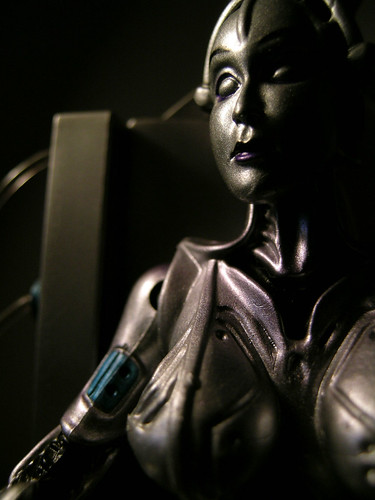
![]() Photo Credit: Ostia via Compfight
Photo Credit: Ostia via Compfight
In my Star Trilogy universe, I created a sentient android. This android debuted in this week’s free short story – Silicants Only. The story was a reworking of the very first short story I ever wrote in Junior High School. That story was two pages long and was called The Robotic Bar. The idea for that story was a response to the scene in Star Wars where R2-D2 and C-3PO were turned away from entering the bar on Tatooine. I wondered what would a bar just for robots look like? Where humans were not allowed inside? What would they be doing in there? Turns out they were plotting against the humans.
That was my first and last robot story until twenty years later when I started writing short stories for publication. I was still interested in the idea of a robotic bar, but I changed the premise of the story to be about a non-sentient android who gets a secret hardware upgrade in the bar that makes it sentient. Now that I had created two kinds of androids, I needed to call the sentient ones something other than androids. I loved the Replicants name in Blade Runner and so I decided to name my sentient androids Silicants, after the silicon that was used in the upgrade chips. Then I got the idea that the silicon came from the desert moon where the story was set – Ocherva. Those two ideas, a sentient android and special silicon found only on one moon, became central concepts in my Space Opera universe.
The android who was converted in that story was named Thirty-seven. The android who upgraded Thirty-seven was Eighty-eight. These two Silicants became central characters in my story lines and appear in many short stories and several novels. Thirty-seven is my everyman android. An innocent being who is suddenly given a gift and must try and hide the fact that it is now a Silicant, from its owner who is a Stellar Ranger. Since Thirty-seven does not know how to deal with the upgrade, it is tutored by the dark and sometimes mysterious Eighty-eight. I liked the dynamic of student and mentor and I especially liked that sometimes the mentor was indifferent to the laws of humans. The same laws that Thirty-seven has always followed without question.
I expanded the scope of Silicants in the first book of the Star Trilogy – Starforgers. That story introduces us to many Silicants some of whom are quite close to the seats of power in the Federation and some of whom are just plane insane. I introduce a Silicant leader named, Seventy-three and several other Silicants who are trying to get recognized as something other than expensive property. Thus was born the Silicant Rights campaign, to liberate and give basic human rights to sentient androids.
The Silicants are about to undergo another physical change in the final book of the Star Trilogy – Starveyors. Each book in the trilogy is set about 500 years apart. In Starforgers, we are first introduced to the Silicants and we learn about how they are created. We see that events are leading to their eventual conflict with their creators, the humans. This conflict leads to their eventual banishment from human space. This is why there are not androids in Starstrikers, the second book of the trilogy. But in the last book they return to human space and they return to prominence in the overall story. After nearly a thousand years in exile, the Silicants have evolved into something more alive than a simple, mechanical android.
Starveyors is a book about reconciliation and for the Silicants that means coming to grips with who they are and where they came from. But they are not the only ones to learn of their true purpose. The humans and their long-time enemies the Votainions also learn about themselves and where they came from. The Great War will eventually conclude and the survivors will begin a new era of peace and exploration. The Silicants will be a vital part of that new era.
There are many more stories to be told involving the Silicants. I’ll be writing short stories and novels that fill in the gaps in their back story, so that by the time I’m done, there will be a rich and detailed history of their origins and destinations. I hope that you will join me on this journey. You can start by reading the Silicant stories in the anthology, Tales From Ocherva, Volume One. If you look at this page, you will see the chronological order of the short stories. All of the shorts take place before the Starforgers novel. The individual shorts are all available as Kindle e-books.


